Dienstag - Sonntag 10.00 - 18:00 Uhr
040 319 79 16 - 0
Sesamstraße – English description
Welcome to our special exhibition „Sesamstraße – more than a TV-Show“!
Sesamstraße celebrates its birthday
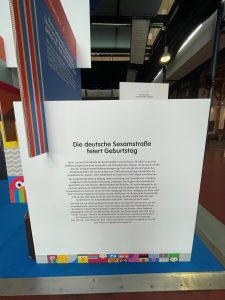
Sesamstraße stands for education, the teaching of values and entertainment – diverse, suitable for children and implemented in a high-quality manner. The muppets, created by Jim Henson, can be seen as role models for children. They are inquisitive, get up to nonsense, make mistakes as well as learn from them, and they are allowed to be the way children (and adults) are: Cheeky like Ernie, excited like Elmo, curious like Abby, or sometimes bad-tempered like Oskar from the garbage can. When Sesamstraße was launched back in 1973, it was the first program to gear its content to the viewing needs of preschoolers – something that still holds true today.
With its self-produced spots and its own stories, NDR has turned the American „Sesame Street“ into a classic of public children’s television in Germany. Entertainment that includes learning lessons for children – educationally valuable and hilarious at the same time. Sesamstraße teaches values, promotes fairness, tolerance and respect, celebrates differences and similarities. It takes children seriously and has enriched and shaped many generations. Spin-offs like „Eine Möhre für Zwei“ (engl. „One Carrot for Two“) have expanded the family and quickly inspired many young and old fans.
The early days: 1971 – 1972
Why Sesamstraße is controversial at first
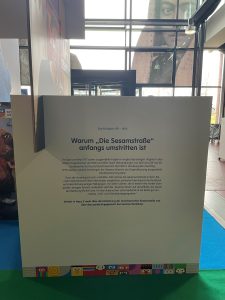
But the programme is also controversial: The living conditions in the USA and in Germany are hardly to compare to each other. That is the main critique from Bayerischer Rundfunk and it gets support from educationalists. Especially the scenes set in a New York slum cause negative reactions. In addition, „Sesame Street“ relies on learning effects similar to those used in advertising. For the Bavarian Teachers‘ Association, the series is even an „advertising, drill and persuasion programme“.
Learn more about the origins of the American Sesame Street and the social commitment of the Sesame Workshop in House 3.
The Synchronous Era: 1973 – 1977
A song for the ages
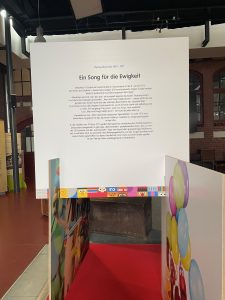
However, with „Der, die, das“, a completely original German theme song is created. And this theme song gets an iconic status: „If you don’t ask, you stay stupid“ – this simple and ingenious sentence is still one of the central messages of Sesamstraße today. It encourages even the youngest viewers to be strong and self-confident: „Be curious! Ask questions if you don’t understand something!“ And „If you don’t ask, you stay stupid“ is more relevant today than ever.
Variety shows like „Peter Alexander presents specialities“ in 1975 are special editions for German audiences. They are filmed on the original location in the USA.
In the seasons from 1976 to 1977, the typical American street scenes are set in Germany. There are many „complaints“ from protesting parents who, among other things, are unhappy with the US setting and the „controversial“ character Oscar (the grouchy rubbish monster). A new frame story is created around the boy Bumfidel and his mother. As these stories are no longer set on a street, the title of the show is temporarily incomprehensible.
The Studio Era: 1978-1988
The German Sesamstraße is born
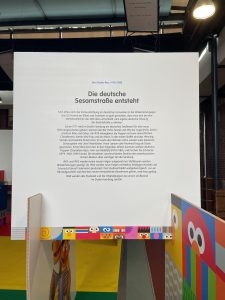
In 1977 already, a German street set for a new frame story is built at Studio Hamburg. Samson the Bear (1978-present) and Tiffy the Bird (1978-2005) replace Bibo and Oskar. From 1978 onwards, the muppets of Sesamstraße interact with two human characters, always a woman and a man. In the first season, Henning Venske and Liselotte Pulver (Lilo) are these human characters. Over the next few years, many well-known actors such as Uwe Friedrichsen, Horst Janson and Manfred Krug are brought in as guests. Real stars of their time. In the following years, Sesamstraße welcomes more new German characters: Herr von Bödefeld (1978-1988), and Finchen (a snail with arms) (1979 -1983, 1989-present). The individual, dubbed sketches of the American version, however, remain an important part of the programme.
No new episodes are recorded in 1984 and 1985. Instead, old episodes reappear. From 1986, new episodes are produced with Bettina (Hildegard Krekel) and Schorsch (Gernot Endemann). The studio set remains largely the same, only a bicycle shop, which belongs to the new human residents is added.
In 1988, the studio set and the original muppets of Sesamstraße are destroyed in a major fire at Studio Hamburg.
Bicycle Shop Era: 1989-1999
The German version emancipates
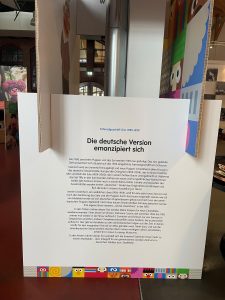
Scenically, a courtyard is added and new characters make their way to Sesamstraße: Rumpel the Grouch (1989-2008), who lives in a wooden barrel, and Buh the Owl (1989-2000), who houses in a hollow tree. While the set provides Tiffy with a new apartment-like living room in the years to come, Samson still lives in his bear cave. The content and look of Sesamstraße are becoming much more „German“.
Find the original barrel of Rumpel and Buh in our exhibition in House 1.
Leonie Löwenherz, a female lion (1986-1989), is presented for a very short time before and after the destruction of the set and the muppets of Sesame Street. Just like Uli von Bödefeld, she was built by German puppet makers and not by the American muppets workshop. After her short career, Leonie gets her own show called „Leonie Löwenherz“ on ARD.
In the early years of this era, older muppets of Sesamstraße are reused for new characters. One of them is Simson, Samson’s cousin, who appears on the show every now and then between 1986 and 1998. At first, Simson is only mentioned by Samson in conversations, other characters doubt his existence until he appears in person. This is comparable with American episodes from that time, where Snuffy is mistaken as Bibo’s imaginary friend.
There is more to find out about this and also how the American Sesame Street makers handled the incidence in an important lesson in House 3 of our museum.
In the last years of this era, the courtyard scene is starts to transform into a marketplace – the epitome of a common social centre in German cities or districts.
The Marketplace Era: 2000-2012
„Eine Möhre für Zwei“ (transl. „A Carrot for two“) first national spin-off in the world.
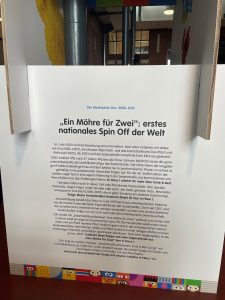
In 2005, Tiffy leaves the show after 27 years of presence. Samson remains the cross-generational identification figure of Sesamstraße to this day. Since 2006, the long-time audience favourites Ernie and Bert (previously only seen in dubbed films) appear regularly in newly produced German episodes. For the 36th season, the two even move permanently into their own flat on Sesamstraße and comment on street happenings from their balcony.
You can find out more about Ernie & Bert in House 1.
Incidentally, many celebrities make guest appearances during this time: Otto, Bastian Pastewka, Jürgen Vogel, Linda Zervakis or even Jan Delay belong to the known guests. Especially unforgettable is Dirk Bach (2000-2007), who wears different costumes in every episode he appears in.
You can find some of these imaginative costumes here in House 1.
For decades, the German producers of Sesamstraße used about 50% of American material, like most of Sesame Street’s international co-productions. But since 2007, the American material is used less, so that an average episode of Sesamstraße now contains only two or three American sketches.
In 2011, the spin-off „Sesamstraße präsentiert: Eine Möhre für Zwei“ (transl. , „Sesame Street Presents: A Carrot for Two“), was launched worldwide for the first time in any country. The main roles are played by Wolle the Sheep and a horse called Pferd. Both muppets are side characters without names in the American version. Wolle and Pferd live in a giant carrot in a backyard in Hamburg and experience exciting adventures. One of their opponents is the green „Wolf“.
Discover this muppet of Sesamstraße and many objects from „Eine Möhre für Zwei“ here in House 1.
In 2011, another spin-off „Sesamstraße präsentiert: Ernie & Bert Songs“ (transl. „Sesame Street Presents: Ernie & Bert Songs“) with 15 music films of 5 minutes each was presented. Among others, they sing songs with guests such as Lena Meyer-Landrut, Jan Delay, Juli and Max Raabe.
Listen to a selection of the songs on our jukebox in House 1.
The Elmo Era: 2012 – today
Clear the stage for Elmo
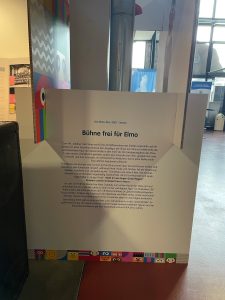
Characters such as Rumpel and Samson retired (even though he continues to appear as a guest til today), while Pferd, Wolle and Finchen remain part of the cast. Established and „Germanised“ characters like Ernie & Bert, the Krümelmonster (Cookie Monster) and Grobi make regular guest appearances. As of 2013, Grobi regularly transforms into „Super-Grobi“.
Want to fly like Super-Grobi? Try our photo spot here in House 1.
In 2017, the little fairy Abby Cadabby makes her first appearance at the show, and over the years she develops into an increasingly important character. In November 2017, the third German spin-off show also premieres. In „Sesamstraße präsentiert: Pizza mit Biss“ (transl. „Sesame Street presents: Pizza with a bite“), viewers experience the adventures of Pferd, Wolle, Grobi and Krümelmonster, who run a pizza restaurant. However, only three episodes are produced.
Since the beginning of 2022, Ernie and Bert are also available in Ukrainian: In „Sesame Street“ for refugee children, spots featuring Ernie and Bert as well as other popular characters from the children’s TV series can be seen in the ARD Mediathek and on KiKA.de.
Did you know…
…that every Sesame Street character has a birthday?
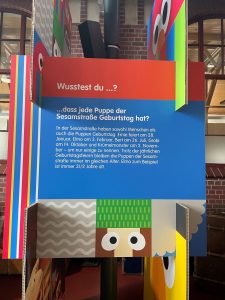
Did you know…
…that Samson cannot speak and move both arms and hands at the same time?
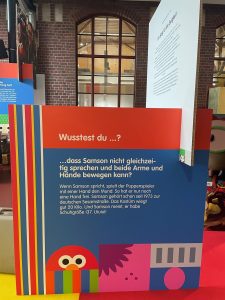
Did you know…
… that well-known German actors were part of Sesamstraße, but never appeared on screen?

Did you know…
…that Bert collects crown caps and paper clips?
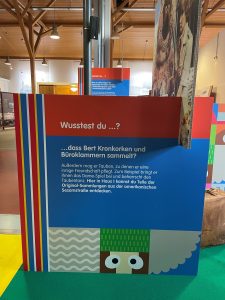
Here in House 1 you can discover parts of the original collections from the American Sesame Street.
Did you know…
…that many episodes of Sesamstraße are available in a version with sign language and one with audio description?
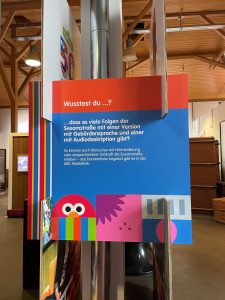
Did you know…
…that Krümelmonster is played by two puppeteers at the same time?
Krümel, Ernie and Pferd are „life-arm puppets“. This means that the puppeteer lends them his own hand. Since he already plays the muppet’s head with the other hand, a special hand player is needed for the second arm. Bert, Wolle and Finchen the snail belong to the group of muppets of Sesamstraße whose arms are guided by chopsticks. Therefore, they cannot grasp.
Did you know…
…that all muppets of the Sesame Street just have four fingers?
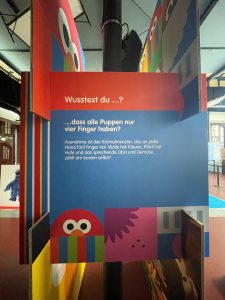
In 2023, the German Sesamstraße will be 50 years old. The American original is even older, seeing the light of day four years earlier. In 2019, this was celebrated all over the world with extra programmes and lots of colourful activities. The cute „50“, which you can see here, is also part of it. She is absolutely unique and a very special loan from the Sesame Workshop archives in New York.
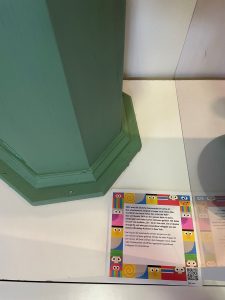
Oscar the Grouch is one of the most famous characters on Sesame Street. Oscar lives in a typical tin bin in the US, sings songs like „I like rubbish“ and is a real grouch with his permanently bad mood. At the time when only the dubbed episodes of Sesame Street are shown in Germany, Oscar is of course a regular guest on German screens.
Suddenly Oscar no longer appears in the German Sesamstraße. The reason for that is the criticism of German parents because they are worried that their children will be infected by Oscar’s nature and want to play in the rubbish. Crazy, isn’t it? In 1989, however, Sesamstraße does get a green grouch again, he listens to the name Rumpel. Instead of living in a rubbish bin, he lives in a large wooden barrel, together with his pet caterpillar Gustav. Rumpel also loves rubbish, junk and stench. At first, Rumpel is always unfriendly, but as time goes by he becomes nicer and nicer, makes friends and allows other muppets to live in his barrel too. Here you can see the very first, original barrel of Rumpel from Sesamstraße.
Günni is a talking toilet who has his home in the giant carrot house where Wolle and Pferd live in the Sesamstraßen spin-off series „Eine Möhre für Zwei“. Günni is a rather special character, as he is one of the very few puppets that was not built in the USA by the muppet makers of the Jim Henson Company. His „father“ is Franz Auer, the puppet maker of the NDR.
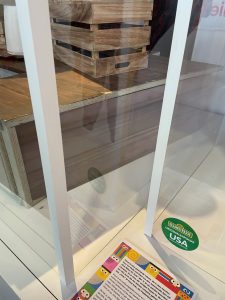
Initially, by the way, Günni was not even planned as a speaking character in the programme, but only as a prop. But his speaking role has paid off. It’s hard to imagine „Eine Möhre für Zwei“ without Günni. In the series´ fourth TV film, „Alarm im Zirkus“ („Alarm in the Circus“) from 2018, he even becomes a leading role. In the film, he is kidnapped by circus people because they have the vision that Günni would be a great circus attraction.
The puppet seen here is a genuine one-off from the NDR archive. It „sits“ in the original set from the programme. You can find more exhibits from the film „Alarm in the Circus“ directly in opposite of Günni.
Finchen belongs to Sesamstraße since 1983. The little orange snail with her yellow snail shell is a real daredevil who likes to skateboard, for example. Finchen has a very big imagination, but can also be totally serious.
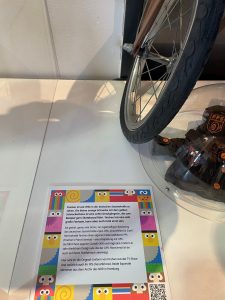
Here you can see Finchen’s original uniform from the TV show. And of course her FPS service bike. Both exhibits are originally from the NDR archive in Hamburg.
Ernie and Bert are among the best-known muppets of Sesame Street. Worldwide, almost every child probably knows them. One of their most iconic features are their colourful jumpers. Ernie always wears horizontal stripes, Bert longitudinal stripes. The two presented jumpers are originals. They wore them in the American production in the 1970s.
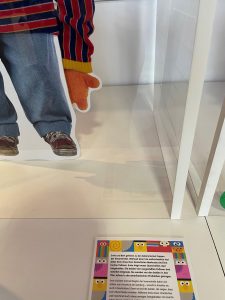
Ernie and especially Bert really love to collect things. Since the two are very different, their favourite objects also differ. Bert likes to collect crown caps and paper clips and to play with pigeons as well. Ernie likes to take a bath with his rubber duckie.
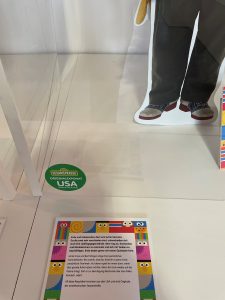
Vehicles are always a challenge for the Sesame Street set designers. They always have to be adapted to the size of the muppets of Sesame Street. And such vehicles are not available off the shelf.
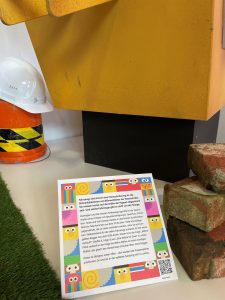
As a representative of the many vehicles from Sesamstraße, a yellow excavator from the NDR archive is displayed. This one can be seen in the episode „Möhre verkauft!“ („Carrot sold!“) (season 8, episode 6) of „Eine Möhre für Zwei“. In the episode, Pferd sells the residential carrot to a windy estate agent, who immediately sends in the demolition squad, including an excavator.
Side fact: The excavator is open at the bottom – that’s where the puppeteers are positioned. However, they are not seen in the episodes.
Elmo is probably the most famous Sesame Street character in the world. While it’s hard to imagine the Sesame Street without Elmo nowadays, he only played a supporting role in the beginning. Now the little fiery red monster is the absolute favourite for many fans. In the USA, he even got his own spin-off show „The Not Too Late Show“ with Elmo. In Germany, Elmo has been the host of Sesamstraße since 2012 and is the focus of the show.
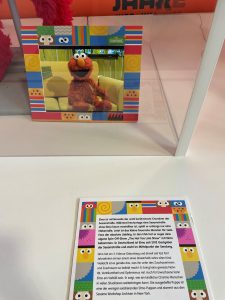
The doll on display is one of the few existing Elmo muppets and comes from the Sesame Workshop archives in New York.
Buh, an old grey owl, joins Sesamstraße in 1989 along with Rumpel and Simson, Samson’s cousin. She is active on the show until 2002.
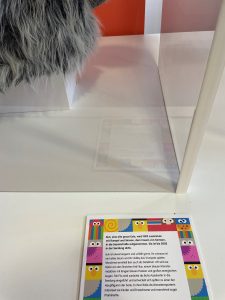
Another Sesame Street icon is Krümelmonster (Cookie Monster). He is known for his chaotic devouring of many cookies and other baked goods. The Cookie Monster has been part of Sesame Street since the very first episode and, if you really want to be precise, his name is Sid. Along with Ernie, Bert and Elmo, he is the most popular muppet of Sesame Street.
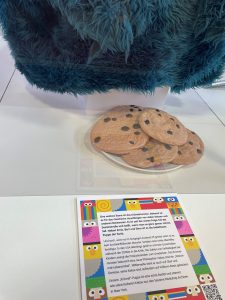
In the USA, however, he and his eating habits came under fire during the 2000s. The alarming figures of childhood obesity forced the producers of Sesame Street to rethink. Krümelmonster gets a new philosophy: „Cookies are a `sometimes food´“, is the new message. Meanwhile, the blue glutton also likes fruit and vegetables, and his cookies are also baked on a wholemeal basis.
Our „crumb“ muppet is a real rarity and, like his delicious cookies, he comes from the Sesame Workshop archives in New York.
Sometimes, Sesamstraße also takes place in the air. For example, in a homemade aeroplane. In season 5, episode 8 „In die Lüfte!“ („Into the air!“) Wolle builds his own aeroplane. But it doesn’t really work – there is a crash.
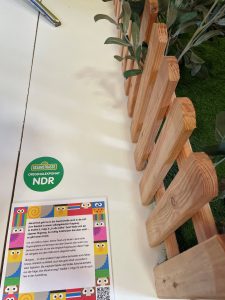
By the way… in another episode the two want to go even higher. More specifically: into space. This also goes wrong and ends in an explosion. The original rocket and Wolle’s astronaut helmet from the episode „Der Mond ist weg!“ („The moon is gone!“) (season 4, episode 19) can also be seen here in the exhibition.
From the beginning, Sesame Street has always featured guest stars. In this way, the American producers want to make the programme more attractive to adults. Superstars like Michelle Obama, Whoopie Goldberg, Johnny Cash, Michael Jackson, Jonah Hill and Heidi Klum can be seen in the US version. And these are just a few names. In Germany, too, celebrity guests often come to visit Sesamstraße. Or, just like Dirk Bach, they get a complete role in the series.
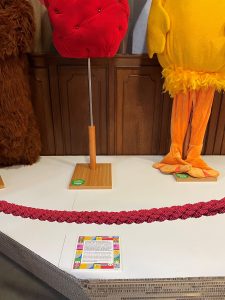
Here you can see four of the imaginative outfits that were specially designed for Dirk Bach by an own costume designer for Sesamstraße: Sabrina von Allwörden. Each costume is unique and is on loan from the costume collection of NDR.
 No. 1
No. 1
It’s probably one of the most iconic scenes in Sesame Street history: Ernie sitting in the bathtub singing to his Rubber Duckie. Ernie’s toy duck is his most treasured possession. Ernie has expressed his fondness for his duckie in several songs.
The initial song „Rubber Duckie“ was first heard by children watching an episode of Sesame Street on February 25, 1970. It was popular enough to be recorded as a 45 rpm single and became a surprise mainstream hit, peaking at #16 on the Billboard Hot 100 on September 26, 1970. Later it was nominated for the Grammy Award for Best Recording for Children.
No. 2
While Sesame Workshop has always highlighted the importance of multiculturalism and inclusivity—and featured a racially and ethnically diverse human cast—it’s never really tackled race and racism head-on. That changed radically when Sesame Workshop was responding to the incidents surrounding the Black Lives Matter movement in the U.S.
In 2021 „Sesame Street“ introduced two new Muppets, a Black father and son, as part of an effort to help children understand racial literacy. In the scene Elmo wants to know why Wes’s skin is brown, so his father Elijah explains the concept of melanin and how „the color of our skin is an important part of who we are“.
No. 3
One of the most important moments of German Sesamstraße is certainly the production of the world’s first country-owned spin-off program of Sesame Street. With „Sesame Street Presents: A Carrot for Two,“ NDR set a milestone for Sesamstraße in 2010. In the 12-minute episodes, Wolle and Pferd, who live in a giant carrot in a Hamburg backyard, master their everyday lives sometimes with coziness, sometimes chaotically.
The carrot universe also includes Finchen the snail from „Sesame Street,“ a green wolf, three crazy chickens and a talking and rather cocky toilet named „Günni. Celebrity guests such as Wolke Hegenbarth, Axel Prahl, Peter Lohmeyer, Steffen Henssler and Herbert Feuerstein also provide support.
 No. 4
No. 4
In 2015 Sesame Street was bringing autism to mainstream media with introducing the Muppet Julia. Julia is one shining example of how the organization has created Muppets who can help broach difficult interhuman subjects through its Sesame Street in Communities initiative, which provides materials and media for kids in a wide range of situations
In 2002, Takalani Sesame, the South African version of Sesame Street, introduced Kami, a 5-year-old HIV-positive Muppet, who was an orphan. Lily, who made her debut in 2011, struggled with food and housing insecurity. Karli, who was introduced in 2019, was in foster care and had a mother who struggled with addiction. And Julia, the Muppet with autism, first appeared in a digital storybook in 2015 before becoming a regular on the show in 2017.
No. 5
Unforgotten for all older fans of Sesamstraße are, of course, Tiffy, Samson and later Herr von Bödefeld. The introduction of these iconic characters in 1978 marks the moment when Sesamstraße begins to develop and emancipate itself from the American version in terms of content. The show is gradually „Germanized“ without losing the inspiration of the original American version. Dubbed parts of the ingenious American Sesame Street always remain part of the German version.
No. 6
When Will Lee, best be known as shop owner Mr. Hooper in Sesame Street died at the age of 74 from a heart attack in 1982, it was certainly not welcome, but it provided Sesame Street with one of its greatest teaching opportunities: how to explain death to children. The episode “Farewell, Mr. Hooper” dealt with the feelings of the muppets towards the topic of loss. Big Bird’s acceptance of Mr. Hooper’s death comes as a climax of this special episode. Mr. Hooper’s portrait gets a spot of honor on Big Bird’s nest to always remember him.
Mr. Hooper’s death was revolutionary because of its frank discussion of a complicated subject that does not fit squarely into the box of children’s entertainment. The episode became a hallmark for Sesame Street, winning accolades and awards, including a Peabody and a Daytime Emmy.
Death was not the only difficult subject Sesame Street dealt with; the show has also tackled hurricanes, divorce, and parental incarceration. But “Farewell, Mr. Hooper” set the precedent for tacking those topics.
 Sesame Street Art
Sesame Street Art
In 2019, Australian curator and Sesame Street fan Eddie Zammit put on a very special art exhibition. To mark the 50th anniversary of the original American series, Zammit invited 50 Australian and international artists to visually explore the popular children’s TV show. To do this, he assigned a different Sesame Street character to each artist for them to interpret their childhood favorites through the eyes of an adult. Reproductions of these pictures can be seen in BallinStadt for the first time in Germany.
Artists
- Dale Bigeni
- Katie Brightside
- Jamie Browne
- Buttons
- Michael Cain
- Lauren Carney
- Stephanie Cartledge
- Cax One
- Gemma Correll
- Aaron Craig
- Sarah Darby
- Marcos Diaz
- Drewfunk
- DXTR The Weird
- Adrian Elton
- Fausto
- Jeremy Fish
- Friks84
- Tom Gerrard
- Glenno
- Kevin Gold
- Melissa Grisancich
- Bobby Haiqalsyah
- Louisa Harrison
- Heesco
- Ink Boy
- JESWRI
- Glenn Jones
- Lisa King
- Luke Lucas
- Keo Match
- Melanie Matthews
- Justine McAllister
- Sarah McCloskey
- Lee McConnell
- Mighty Short
- Nicolo Nimor
- Numskull
- OX King
- Phibs
- Travis Price
- Kate Pullen
- Pat Rogasch
- George Rose
- Nick Rudenno
- Silk Roy
- SKTCH
- Greg Straight
- Mitch Walder
- Kentaro Yoshida
The longest street in the world
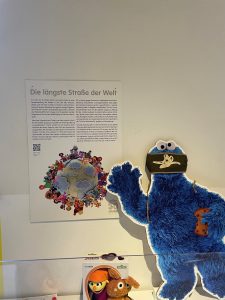
At the core of the organisation’s mission is ensuring children from all social backgrounds early access to quality education. Since its earliest days in 1969, Sesame Workshop has risen to the challenge of nurturing the minds and hearts of children. And it’s done so with the help of the Muppets of Sesame Street, who help model behaviors that can help change attitudes and cultural norms.
Whether fighting racism, childhood obesity, intolerance, health and hygiene challenges, or the barriers to education for young girls, Sesame Workshop stands for respect, kindness, a sense of humor, and equal access to quality education. And it does so around the world – whether in Latin America, Europe, Africa, the Middle East and Asia, or in its own homeland of the United States. In Germany, the most present and popular work of Sesame Workshop is the TV show Sesamstraße – loved by generations.
Sesame Workshop is considered the largest informal education provider in the world, reaching 150 million children every day, making it an innovative force for change. They are present in over 150 countries, serving children through a wide range of programs, all of which are grounded in rigorous research and tailored to the needs and cultures of the communities they serve. Sesame Street literally circles the globe, and has thus become the „longest street in the world“ (in the original English, Sesame Street is called „longest street in the world“ due to its global success).
1960s / 1970s
ENTERTAINMENT MEETS EDUCATION – How television can help children learn and grow
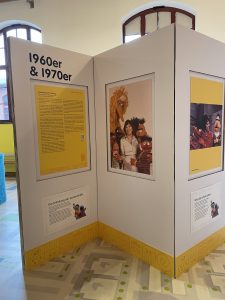
Talking to a friend, educational psychologist Lloyd Morrisett, she learned how Mr. Morrissett’s 3-year-old daughter sat in front of the TV screen every Sunday morning at 6:30 a.m., waiting for the TV program that started at 7:00. Mrs. Cooney was fascinated. She realized that this observation was exemplary for millions of American households – rich and poor alike. And in that fact, she saw potential.
Just two years earlier, U.S. President Lyndon B. Johnson had launched his „War on Poverty,“ vowing to close the great education gap between the rich and the poor. It was the perfect time for big, bold ideas in education when Mrs. Cooney released an impactful report: “The Potential Uses of Television in Preschool Education.“ It became a blueprint for a new kind of show – one that fuses education and entertainment. She developed a way to narrow the education gap by giving preschoolers from more deprived backgrounds some of the educational advantages enjoyed by their middle-class peers.
In November 1969, the first episode of Sesame Street aired in the United States on regional Public Broadcasting Service stations. Back then, Mrs. Cooney’s team consisted of the creative Jim Henson, who brought his iconic cast of puppets called Muppets; Lloyd Morrisett, educational psychologist, co-creator of Sesame Street and Vice President of the Carnegie Corporation to help secure funding; as well as educators and social workers, to create a new type of show. The Children’s Television Workshop (CTW) was on its way.
The show’s approach was revolutionary and the setting of a street called Sesame Street resembled the urban streets where many of the viewers lived. A similar philosophy applied to the interracial cast – extraordinary for the time – where children with disabilities were included from the beginning. Today, we know how important it is that viewers of all backgrounds can relate to the characters of a show. Sesame Street highlighted that important message of inclusion from the start, and never looked back.
Animation, songs, and real human stories were all included in Sesame Street. Guest appearances by celebrities and parodies were incorporated with the deliberate intention of appealing to adults as well; the show’s creators believed learning would be more impactful if an adult were watching with a child. The show, which embraced a whole-child curriculum, taught academic basics like the ABCs and 123s and socioemotional skills every child needs to thrive.
Embracing its eclectic and unusual nature, children and parents alike loved Sesame Street from the beginning. However, the show’s diverse, multiracial cast wasn’t universally welcomed. Shortly after the show’s launch, Mississippi’s State Commission on Educational Television voted to ban Sesame Street on public television because of it showed children of different races playing alongside each other. But just 22 days later, the ban was overturned after protests and letters to the State Commission.
Within a decade, Sesame Street became the most revolutionary children’s show in the United States with 9 million American children under the age of six watching the stories about Bert and Ernie and their human friends every day. Television was changed forever.
HOPE BEHIND BARS – Helping children and incarcerated parents stay close
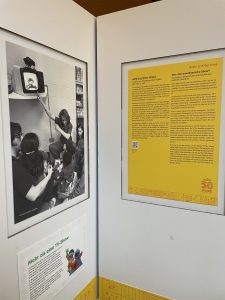
At this time, following the Attica prison riot of 1971 in New York, there were nationwide discussions about prisoners‘ rights and racial inequality, particularly in the prison system. At the Children’s Television Workshop (CTW), now Sesame Workshop, they were listening and studying these issues. Studies of recidivism among prisoners showed that those who lost touch with their families while inside were more likely to be violent and return to prison after release. Children were also nervous to visit an incarcerated parent, but still missed Mom or Dad and didn’t understand why things had to change. That’s why, in 1975, CTW established a series of children’s centers in prisons across the country, equipped with child-sized toys, books, and furniture. It is the first time incarcerated parents were given the opportunity to be with their children while in prison and build better relationships – one of the most important factors in an inmate’s successful readjustment into society.
These efforts expanded in 2013 with Sesame Workshop’s Little Children, Big Challenges program. This program included new resources – videos, activities and games, and guidance for visiting mom or dad in prison – to help young children and their families stay connected.
AN ALL-AMERICAN SHOW? The first international co-productions take shape
Joan Ganz Cooney and her colleagues originally wanted Sesame Street to be a quintessentially American show, dealing with challenges facing American children and based on a typical American street.
However, people around the world recognized this revolutionary way to reach and teach preschoolers, and wanted their own street – with preschool education and the beloved Muppets of Sesame Street– and a healthy dose of fun. They came to Mrs. Cooney and her team for help in creating local versions of the show.
Working hand-in-hand with local educators, writers, artists, producers, and researchers, new versions of Sesame Street were developed, tailored to the children’s specific needs, in their own language and based on their own culture so children could relate to their version of Sesame Street as strongly as their American counterparts did.
One of the first co-productions was Vila Sésamo, a Portuguese-language Sesame Street created in Brazil in 1972. That same year, a Spanish-language version, Plaza Sésamo, launched in Mexico. Local Muppets of Sesame Street were introduced, including Abelardo and Paco, and local stories were developed and set in an open town plaza, which felt more authentic for the Latin American audiences.
And that was just the beginning. In the early 1970s, more Sesame Street formats followed in Canada and Germany, there in cooperation with NDR. Many more co-productions around the world followed. Each had the spirit and ethos of Sesame Street, but co-productions were always firmly anchored in the local culture. Today, Sesame Street reaches around 150 million children in more than 150 countries every day: a global success!
1980s
A ROAD FOR ALL – Reaching communities in need
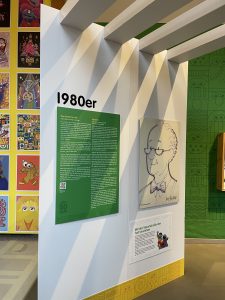
This involved working directly with and in communities. The Sesame Street Fire Safety Program materials were developed, and fire departments were brought to preschool settings to reiterate safety lessons to children. These resources are still impactful; The Sesame Street Fire Safety Program was so well received that it is still used today– a good 40 years later.
This fire safety theme was just the beginning. In the 1980s, a series of outreach programs launched, covering the issues that affect young children most. One example included education about asthma, one of the most common causes of emergency room visits for children. With proper care and management, children with asthma can live a healthy life. Other topics addressed included lead exposure and road safety.
Today, Sesame Workshop uses its beloved furry friends to address the most pressing challenges children face, from homelessness to parental incarceration to displacement. And the work doesn’t stop there. Sesame Workshop is constantly working to respond to new challenges facing children in an ever-changing world.
Grief and loss – How to help a child understand death
In 1983, Sesame Street once again pioneered children’s television by helping children understand death. When Will Lee, the actor who played the beloved market owner of Hooper’s Store, died suddenly of a heart attack in late 1982, the show’s creators asked themselves if and how it could continue to be the same without its central character.
How should this loss be dealt with? Should another actor take his place? Or would Mr. Hooper simply be „written out“ of the series? All options struck Joan Ganz Cooney and her team as dishonest. They decided to tackle the issue in typical Sesame Street fashion so young viewers could understand and process their feelings.
Central to the on-screen grief processing was Big Bird (known as Bibo in Germany), who asks, angry and confused, about Mr. Hooper’s death: „Why does it have to be this way?“ The answer he gets is „Just because.“ The reasoning for this response: „We chose this open-ended answer on purpose to allow parents to continue the conversation with their children – based on their own cultural or religious beliefs.”
The lesson the TV makers conveyed is this: not everything has a reason. Unfair things happen. And it’s OK to be upset about it. But it’s important to be there for each other – especially when things won’t be the same.
And so, Big Bird and all the other characters and actors on the show say goodbye to Mr. Hooper on screen. Big Bird hung a picture of Mr. Hooper in his nest, conveying to millions of children on their screens that this is how they will always remember their beloved neighbor together. And that saying goodbye will be easier because of it.
The effect of the special broadcast on the topic of „goodbye“ was evaluated. Researchers talked to children before and after the episode. They found that nearly 75% of 4- and 5-year-olds who watched the show understood that Mr. Hooper died and won’t be coming back. The children met the honesty of the message with acceptance and understanding. Parents reported „overwhelmingly positive“ reactions to the delivery method and how they openly discussed death with their children afterwards.
Today, Sesame Workshop’s resources on coping with grief builds on these experiences, offering assistance to families and especially children who lose a parent or loved one. „We make sure children get the support they need to deal with death and move forward in their lives,“ says Mrs. Cooney.
1990s
RESPECTING DIFFERENCES – In the Middle East
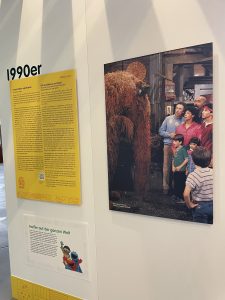
During this time, Sesame Street developed a powerful new model to bring together the different views of generations. It brought teachers and producers together to help children of both sides better understand the situation in which each one lived. However, a multicultural street like the model of the American Sesame Street couldn’t work – differences and conflicts were too huge and a multicultural street didn’t reflect children’s realities. The solution: two shows and two new Sesame Streets were created. First, in 1982, the show Rechov Sumsum in Israel, followed by an Israeli-Palestinian co-production Rechov Sumsum/Shara’a Simsim in 1998. Characters of the two shows invited each other onto their own streets amicably and appreciated their similarities and differences. The show’s creators, which included psychologists and social workers, used the productions to portray situations that emphasized friendship, helpfulness, and collaboration.
The show had proven impact on its viewers. After it aired, for example, a 2009 study found that Israeli children showed far more willingness to talk instead of fight while young Palestinian children were more cooperative and helpful. This model has since been used in other countries and crisis areas, such as Northern Ireland and Kosovo.
HIV EDUCATION WITH KAMI – How a spirited Muppet of Sesame Street breaks a taboo
In the 1990s through the early 2000s, nearly every family in South Africa was affected by the HIV and AIDS epidemic. More than 2 million children were orphaned by the disease. They lived with the physical and emotional burden of it, as well as loss, social exclusion, and stigma.
To improve awareness for parents and caregivers, Sesame Workshop partnered with the South African Department of Education to create the first HIV/AIDS curriculum for young children, focused on knowledge, attitudes, and skills. Sesame Workshop developed parallel radio and television productions as part of Takalani Sesame, the South African co-production that launched just a few years prior in 2000. The centerpiece of the campaign was the bright yellow, furry, 5-year-old character Kami, who was HIV-positive and, like many children, was an AIDS orphan. Kami was able to break down the culture of silence surrounding the diseases, changing perceptions and increasing awareness of how the disease was—and wasn’t—spread. In one episode, Kami shares that her friends at school don’t want to play with her because they think they will get HIV/AIDS by touching her. Kami’s Takalani Sesame friends share that you can’t get HIV/AIDS by touching and invite Kami to play with them—breaking down stigma and modeling inclusive behaviors for young viewers.
Research showed that children who watched Takalani Sesame were more likely to have more knowledge of the disease and how it was spread. Another study showed that parents and caregivers who watched the Takalani Sesame special Talk to Me, in which children and parents openly discuss HIV and AIDS, are twice as likely to engage in conversation with their own children than those who did not watch it.
Kami quickly became a role model for children and adults alike, both within South Africa and around the world—even becoming recognized by UNICEF as a Global Champion for Children.
2000s
COPING WITH TRAGEDY – How Sesame Street deals with tragedy
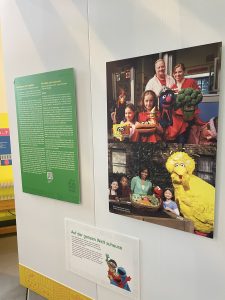
Children were scared and parents needed help explaining what was going on—and Sesame Workshop believed they could help preschoolers feel safe again after one of America’s darkest days. But how? The Workshop knew it needed to help children cope with the stress and anxiety of 9/11’s aftermath without scaring them further. And beyond the attack itself, many children of Middle Eastern descent were facing increased racism and bullying. Sesame Workshop assembled a team of child psychologists and other experts to inform its approach. The solution was not to talk directly about 9/11 but to use analogies to depict the events across a series of Sesame Street episodes. In one episode, a fire breaks out in Hooper’s Store. After the fire is extinguished, Elmo is scared and doesn’t want to enter the store again. A firefighter sits down with Elmo and explains his work and his equipment—and, most importantly, lets Elmo know that firefighters like him are there to keep kids like Elmo safe. Elmo calms down. It’s ok to be scared, Elmo learns, but adults are there to protect him.
In another episode, Gulliver the Seagull, Big Bird’s pen pal, comes to visit. Gulliver doesn’t want to play with Snuffy because he only plays with birds and Snuffy, of course, is not a bird. Big Bird stands up for Snuffy and lets Gulliver know that “A friend is someone you care about and enjoy doing things with. It doesn’t matter what the person looks like.” Gulliver learns to respect and embrace Snuffy’s differences, modeling an important lesson for children. Episodes on loss and coping followed. Future responses to natural disasters and global tragedies, like Hurricane Katrina and the tsunami that devastated Japan in 2011, were built on this work. When disaster strikes, Sesame Workshop’s goal is to help children feel safe again.
WE ALL LIVE TOGETHER – Finding common ground across ethnic borders
Kosovo
The Kosovo war of 1998-99 tore apart the fabric of Kosovar society, reigniting long-dormant ethnic animosities. As a result of the conflict, there was widespread mistrust, limited access to education, and little hope for the future.
Building on its experience in Palestine and Israel, Sesame Workshop wanted to foster mutual respect and understanding between children from different ethnic backgrounds. But the situation in Kosovo after the war complex. Mistrust between the country’s ethnic groups and even Americans, because of NATO’s role in the war, weighed heavily on the population and, in turn, on children.
In 2004, a co-production in two languages was launched: Rruga Sesam in Albanian and Ulica Sezam in Serbian. They were the first locally produced programs in Kosovo to convey important learning and express a vital message: To see our commonalities and don’t be blinded by differences.
In Kosovo, children of different ethnicities lived completely separate lives. For example, there were separate school systems and no shared bus rides. Serbian children learned the Cyrillic alphabet, while Albanian children learned the Latin alphabet. Language became a barrier.
Because of the strict separation, Sesame Workshop could not simply show the two ethnic groups in a single production or in one language. So other children of different origins were included – Turkish, Bosnian, and Croatian children, as well as Roma and Gorani. Sesame Workshop also created a visual dictionary, where children from different groups named an object in their own language. Language once divided them, but now it had the power to connect and educate at the same time.
Northern Ireland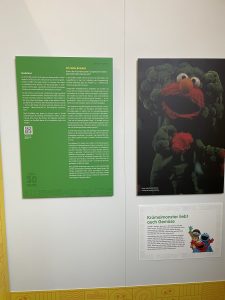
As the borders between the opposing sides were opened, the two Characters Hilda and Potto became border openers themselves. In the show, Potto removes a barrier splitting the tree they live in in half, saying, „There are things on my side of the tree that you need … and there are things on your side of the tree that I need.“ Hilda agrees with him: „That sounds like our answer.”
After conflicts like those in Kosovo or Northern Ireland, the formerly hostile parties did come up with a solution: You have to educate children, the next generation, to deal with and avoid conflicts of this kind.
„I LOVE BROCCOLI“: Can the Cookie Monster be an advocate for healthy living?
In the early 2000s, one in three children and adolescents in the United States were obese or overweight. Sesame Street tackled the problem – with the help of a bunch of singing vegetables.
Unhealthy behaviors take root quickly and are slow to change. Habit development is especially crucial at a young age. A 2010 study found that preschoolers are more likely to enjoy eating vegetables – even broccoli – when linked with their favorite Sesame Street characters. That’s what the Healthy Habits for Life campaign is about.
This program used the Muppets of Sesame Street to encourage children, as well as parents, to make healthier eating choices. With health experts, Sesame Workshop developed appropriate resources to teach healthy habits. The campaign was based on simple key ideas. Messages that children understand and are memorable, such as „Eat the colors of the rainbow“ or „Get up and move your body.“ Many children needed to be reached, so healthy eating extended beyond episodes of Sesame Street. There were touring exhibitions, podcasts, books, and partnerships with brands and products to reinforce the campaign.
In one episode, even former First Lady Michelle Obama stopped by Sesame Street to plant a vegetable garden with Elmo. The First Lady explained how food helps children grow up and become strong, just like her and Big Bird.
The key was to reach out not only to children, but also to providers such as schools and community centers, and to inspire them to change what they offer in their cafeterias. Specially developed packages with relevant information on healthy eating have been distributed to around 6 million facilities to date.
Cookie Monster was also involved in the campaign when addressing “sometimes foods” and “anytime foods” with children. These concepts help differentiate between nutritional foods and treats, cookies.
Eating healthy can be undermined by poverty, which is why the campaign was expanded to include the fight against hunger. Through primetime broadcasts and resources for families, Sesame Workshop supported families who were coping with food insecurity.
WHEN A NATURAL DISASTER STRIKES – Sesame Street’s neighborhood faces a crisis together
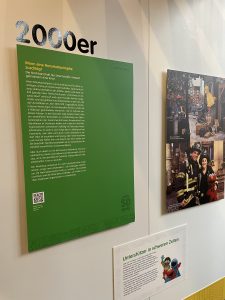
But Sesame Workshop also helped directly on the ground: the Muppets of Sesame Street including Elmo, Rosita, and other friends were deployed to provide comfort in the affected areas, especially in emergency shelters, and delivered furry hugs.
Sesame Workshop also developed You Can Ask materials for emergency preparation. These resources provided strategies for coping with hurricanes, ease fears, and ways to restore normalcy and helped caregivers and parents provide children the right answers in tough situations.
2010s
BIGGER DREAMS, BRIGHTER FUTURES – How the Muppets from Sesame Street are inspiring a whole generation of girls
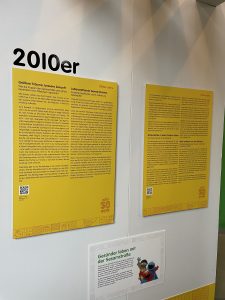
For example: in Afghanistan, it is primarily girls who have a hard time or are even prohibited to attend school. The rate of women who can write and read in Afghanistan is only around 24% – one of the lowest in the world. The Afghan co-production Baghch-e-Simsim premiered in the nation’s two official languages in 2011 and quickly gained millions of viewers. In 2016, 6-year-old Zari was introduced as the first original Afghan character. She wore a school uniform and the customary headscarf for schoolgirls, the hijab. Zari was curious, asking questions, learning about different careers, and talking about her dreams for the future, becoming a role model for many young girls in Afghanistan. In 2017, Baghch-e-Simsim introduced Zeerak, Zari’s younger brother, who helped to model gender equity by looking up to his big sister and participating in household chores and responsibilities that challenged gender stereotypes. While the show was impactful for young viewers, it was similarly insightful for parents. Parents who watched the show and knew the characters were more likely to send their daughters to school than parents who did not watch.
However, since the Taliban gained power in 2021, Baghch-e-Simsim has been off air. The conditions and professional opportunities of young girls and women have deteriorated radically.
LIFE-SAVING HABITS – Fighting serious diseases through education
Poor sanitation poses a major threat to children’s health. But with the help of Raya, Sesame Street’s global health ambassador, hygienic behaviors are being taught and lives are being saved.
The leading causes of death for children under five worldwide are preventable and treatable illnesses related to poor sanitation and hygiene, like diarrhea and pneumonia. Simple hygiene measures and changes in behavior can meaningfully reduce the prevalence of these illnesses. Sesame Workshop’s characters have a unique ability to model behaviors, provide language to talk about tough topics, and tackle taboos. With support from the Bill & Melinda Gates Foundation, the WASH UP! Initiative launched in 2014 in Bangladesh, India, and Nigeria. At the center is Raya, a very special character. She’s 6-years-old, with long braids and a beaming smile, and she teaches children in 11 countries and 30 languages life-saving lessons about water, sanitation, and hygiene.
Raya is Sesame Workshop’s global health ambassador and was designed to reflect her mission. For example, Raya loves the smell of clean hands. Her own appearance also contributes to better hygiene behavior. She wears sandals to always have clean feet after going to the latrine, and her tied-back hair is also evidence of tidiness. She appears strong and healthy. Raya can be used in many countries, because her green felt color does not reflect one particular skin tone.
The key hygiene messages that Raya focuses on help create positive behavior change that ultimately reduces the risk of infection. She appears in teacher’s manuals and storybooks and is also featured in classroom games and videos around the world.
Children who participated in the WASH UP! program in Nigeria were twice as likely to wash their hands after going to the bathroom, while 49% more children in Bangladesh wore sandals consistently when going to the bathroom than before the program. When children learn hygienic habits, they carry their knowledge back to their families, building a foundation for good health moving forward.
As Sesame Workshop works to expand WASH UP! to more countries, Raya will continue saving lives with simple behavior changes. It’s amazing what a character with a bar of soap can do!
SEEING AMAZING IN ALL CHILDREN – A new friend comes to Sesame Street
Sesame Street can also be a lifeline for those with atypical needs. Julia, the very first Muppet from Sesame Street with autism, helps children overcome the challenges autism can bring. She helps raise awareness and understanding. Diversity and inclusion have been part of Sesame Workshop‘s mission from the beginning. The goal is to promote respect and understanding for people with different backgrounds, needs, and experiences. For example, people with disabilities repeatedly appear in episodes of the U.S. Sesame Street. For example, Jason Kingsley – an actor with Down syndrome – appears in more than 50 episodes, counteracting prejudices and misunderstandings.
Since 2017, Sesame Street has addressed the topic of autism Initially, Julia appeared in a digital storybook, but after the positive response from audiences, Sesame Workshop knew Julia needed a larger role, leading to the episode „Meet Julia“ on Sesame Street. Julia is a 4-year-old character who loves to paint, play, and learn. In the episode, Big Bird and Elmo interact with Julia. At first, Big Bird doesn’t understand Julia’s behavior. With the help of friends, he learns that Julia has autism, and that she is doing things in a “Julia sort of way.”
Julia’s impact is evident. The impact: 70% of parents who do not have an autistic child showed an increase in knowledge and acceptance of autism after using the resources from Sesame Workshop and 53% of parents of autistic children reported an increase in their comfort level about involving their child in their community.
The initiative See Amazing in All Children was developed in cooperation with 14 autism organizations and 250 experts. The goal is to support families of children with autism and to increase understanding autism in society. Julia is now known internationally as an ambassador for these goals. In countries such as Japan, the United Kingdom, and Singapore, she helps contribute to Sesame Workshop‘s goal to raise awareness and acceptance around the world.
Far from home – Helping refugee children learn and develop
More than around 400 million children live in areas currently affected by violent conflict, and around 35 million children all over the world have been forcibly displaced. Many have lost homes and loved ones and endured experiences that can create devastating long-term effects on their learning and wellbeing. But children are remarkably resilient, and we know that if they have access to quality early childhood development (ECD) support, they can overcome adversity and build a brighter future. That’s why early action and programs are crucial. And early learning in the form of playful interaction is an essential approach.
All over the world, in the Middle East, Bangladesh, Ukraine, Latin America, East Africa, and Afghanistan, the Welcome Sesame initiative unites programs with a shared goal of delivering early learning and nurturing care to young children and caregivers affected by crisis—reaching children in the narrow window when it’s most important. For that, Sesame Workshop found strong funders and partners such as the MacArthur Foundation, the LEGO Foundation, the International Rescue Committee (IRC), and BRAC. For example, the MacArthur Foundation and LEGO Foundation have each contributed a historic $100 million to Sesame Workshop’s efforts to deliver early childhood development to children affected by conflict and crisis. Welcome Sesame focuses on four outcome areas for children, families, and educators: improved foundational skills, improved health outcomes, increased safety and protection, and improved capacity to build strong and responsive relationships.
In the Middle East, Sesame Workshop is reaching children through Ahlan Simsim, which means “Welcome Sesame” in Arabic. Through a locally-produced TV show and in-person services featuring storybooks, educational materials, and caregiver-facing programming across Iraq, Jordan, Lebanon, and Syria, Ahlan Simsim reaches families wherever they are—from classrooms and health clinics to TV and mobile devices—with the educational resources and playful learning children need.
At the heart of the program is Ahlan Simsim, a show that features familiar faces like Elmo and Cookie Monster, but also specially-designed characters that reflect the unique needs and storylines of children in the region. Basma, an almost-6-year-old purple character, welcomes her yellow-furred friend Jad with open arms when he moved to her neighborhood, and their playful learning adventures continue as their friendship grows. The show also features lovable characters like Ma’zooza, a baby goat who eats everything in sight. To date, Ahlan Simsim has reached over 23 million children across the Middle East and North Africa through mass media, and 1 million children through direct services in Iraq, Jordan, Lebnon, and Syria—making it the largest early childhood intervention in the history of humanitarian response.
Coping with big feelings – How Sesame Street helps children cope with trauma
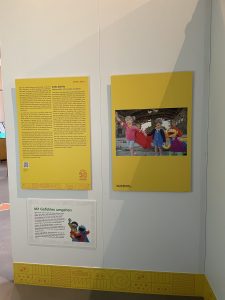
In the wake of COVID-19, mental health challenges are among the most significant threats to children’s well-being. Right now, Sesame Workshop is rapidly developing a comprehensive initiative to help destigmatize mental health distress and equip both parents and community service providers to nurture children’s emotional well-being.
2020s
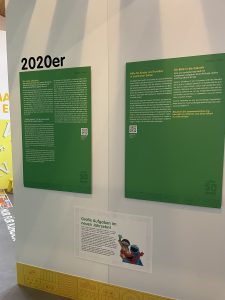
„Coming Together“: helping children celebrate race, ethnicity, and culture with Sesame Street
Since the 1960s, race, ethnicity, and culture have played a central role in the show’s implementation. More than fifty years ago, Sesame Street broke new ground with the first multiracial and multicultural cast on children’s television. Promoting diversity of all kinds and the idea that children of all races, ethnicities, genders, family structures, social classes, religions, and countries of origin are welcome on Sesame Street has been at the heart of Sesame Workshop’s work ever since – always knowing that young children are attentive observers who actively try to make sense of the world around them.
In 2020 in the United States, children and families were struggling to make sense of the protests happening across the country in the wake of the murder of George Floyd as well as increased anti-Asian racism. Sesame Workshop knew they had a role to play in helping families stand up to racism and foster positive self-identity.
The Coming Together initiative is designed to help children grow up with a positive self identity and sense of belonging, with research-based materials that engage the whole family and invite parents and caregivers, educators, and providers to help children celebrate their own race, ethnicity, and culture and stand up for themselves and others. Sesame Workshop introduced new characters to help children celebrate their own unique identities. Cousins Tamir and Gabrielle, who are both Black, are members of the Power of We Club, where alongside other Sesame Street friends they learn how to become upstanders to unfair treatment based on skin—or fur—color. Sesame Workshop also introduced Wes Walker and his father Elijah, who help model tough conversations between parents and children. Ji-Young, introduced in 2021, is a Korean American girl who loves to rock out on her guitar. Debuting in the Sesame Street special “See Us Coming Together,” Ji-Young helps children celebrate the rich diversity of Asian and Pacific Islander communities.
Helping children and families in uncertain times
Since the beginning of the COVID-19 crisis, Sesame Workshop has been providing support to children and families worldwide in the tradition of Sesame Street. After all, Sesame Street and its beloved friends like Elmo and Cookie Monster have long been a reliable source of comfort in difficult times. The Caring for Each Other initiative aims to provide families with a sense of stability.
In the early days of the pandemic, Sesame Workshop quickly produced a series of animated Public Service Announcements to promote handwashing and healthy habits. The videos aired in 41 languages in 102 countries around the world. Sesame Workshop also produced a primetime television program and several CNN Townhalls that helped children continue learning and playing while remaining safe at home, as well as helping them cope with the big feelings so many children were experiencing.
Looking into the future
Sesame Workshop is an innovative force for change, with a mission to help kids everywhere grow smarter, stronger, and kinder. As the world changes, Sesame Workshop continues to adapt to meet the most pressing needs of children and families, whatever they may be.
Sesame Workshop is a non-profit organization and their work is only possible because of generous philanthropic support. Visit sesameworkshop.org to learn more and support this work.
Did you know…
… that Sesame Street has won the most Emmy Awards in the world?
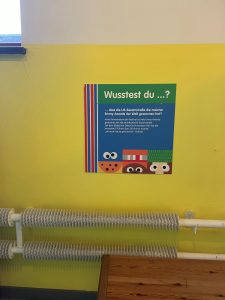
Did you know…
… that there is a character with a Grammy nomination?
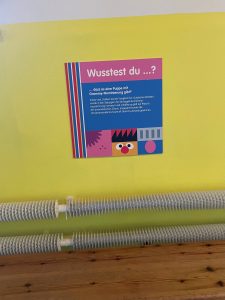
Did you know…
…that Sesame Street exists in the real world?
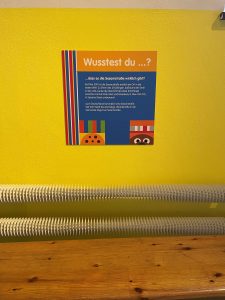
Did you know...
… that the American TV show has a different theme song?
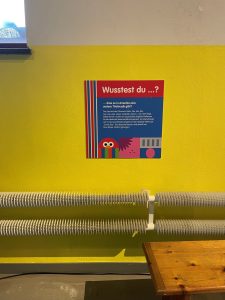
Did you know…
… that Elmo has spoken in front of politicians?
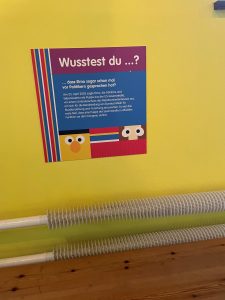
Did you know…
…that there is a term for the effectiveness of Sesame Street‘s approach?
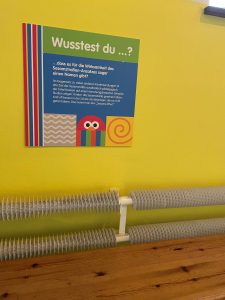
The lovable characters of the Sesame Workshop have the unique ability to teach children behaviour and topics that adults consider as taboos. These include, for example, going to the toilet and menstrual hygiene. One example how the muppets of the Sesame Workshop help, is Raya, the global health ambassador of the organisation.
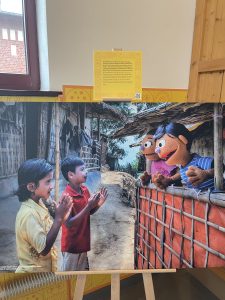
Raya is the figurehead of the Sesame Workshop’s global campaign „WASH UP!“. It teaches children in more than 15 countries so far about sensible sanitation and hygiene measures. Books, games, videos and training materials featuring Raya and her friends for ever teacher and educator make healthy habits easy to understand, practical and implementable.
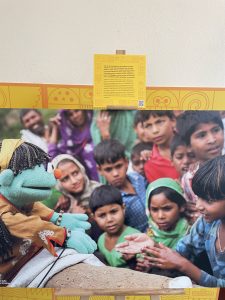
The muppets of Sesame Street are real works of art. Almost all of them are made by the Jim Henson Company in the USA. Each muppet is planned from scratch, there are different designs, also fabric samples for the right colouring are compared, and colours as well as clothes are chosen. Each muppet should have its own unique character and personality.
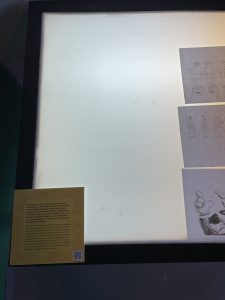
If you want to learn more about the design and handicraft production of Sesamstraße, we recommend our partner exhibition „Sesamstraße. 50 Jahre Wer, Wie, Was!“ („Sesame Street. 50 Years Who, How, What!“) at the Museum für Kunst und Gewerbe (MK&G). From May 7, 2023 to January 8, 2024, you can learn there how the muppets, sets, costumes, props and musical pieces are developed.
Joan Ganz Cooney can be seen as the inventor of the Sesame Street. Teamed up with US psychologist Lloyd Morrisett († 15 January 2023), she founded this non-profit organisation behind the Sesame Street.
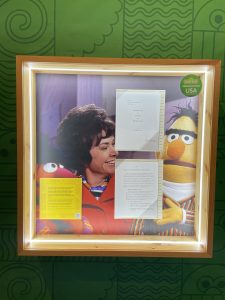
Morrisett was probably the first to come up with the idea of teaching pre-school children letters and numbers via television. Ganz Cooney takes up the idea and publishes an all-changing report on the „potential benefits of television in preschool education“. That‘s the birth of Sesame Street.
Here are some sheets of their work. They are original copies from 1969 – borrowed from the Sesame Street archives in New York.
Bibo (in the original American version „Big Bird“) is one of Sesame Street’s most imposing puppets. With a height of 2.49 meters, the yellow bird towers over all the other characters. The muppet was developed by Jim Henson himself.
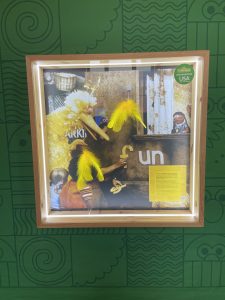
In 2000, Bibo was called a living legend by the United States Library of Congress. What an honour! Here you can see some of Bibo’s original feathers from the Sesame Street Archives in New York.
The biggest passion of Krümelmonster (in the American Sesame Street „Cookie Monster“) is, of course, eating cookies. But nowadays, the blue monster evolved as a real ambassador for healthy food in the American version of Sesame Street.
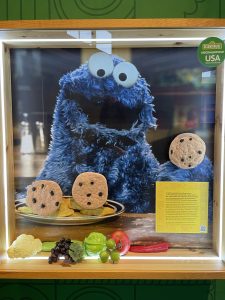
The food industry cleverly uses shapes and colourful packaging with funny motifs to make their products attractive to children. Food manufacturers‘ commercials on television captivate children. How can vegetables like carrots or broccoli compete with that? Sesame Street’s answer: By letting one of the most popular characters of the Sesame Street eat healthy.
Cookies are therefore only a „sometimes food“ for Krümelmonster, but fruits and vegetables are on his menu every day.
By the way, here are some original cookies from the Sesame Street we were able to save from Krümelmonster.
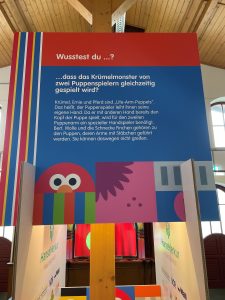
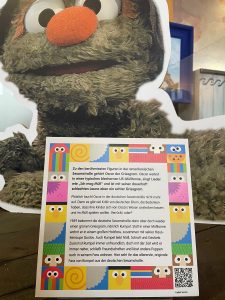
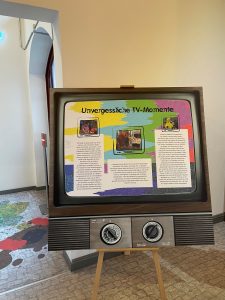 No. 1
No. 1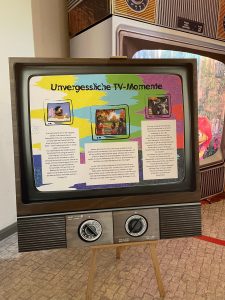 No. 4
No. 4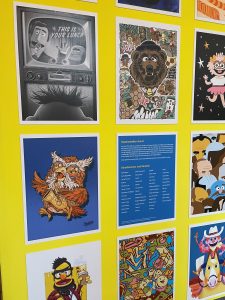 Sesame Street Art
Sesame Street Art